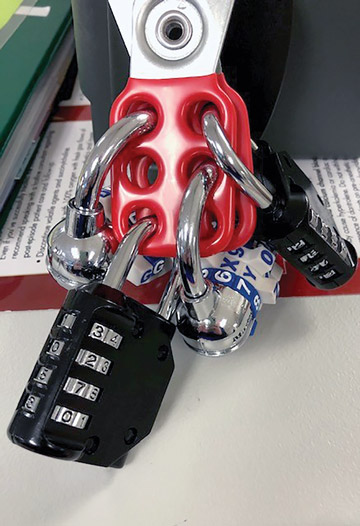There are several ways to ensure your staff is properly trained to handle a malignant hyperthermia emergency. Making them sit through yet another annual in-service or having them read dry educational materials would certainly get the job done, but creating an MH escape room would make the training memorable, challenging — and a lot of fun.
Escape rooms have been a popular form of entertainment for years. They involve teams working together to solve puzzles or clues in order to "escape" the room. It's a perfect team-building exercise, and that's why I decided to use the concept to capture my staff's attention when it was time to review how they should manage an MH emergency. Here's what it takes to pull it off.
- Order the materials. You'll need some combination locks, lockable boxes and a lockout hasp, which can hold up to six padlocks. These boxes are ideal and can be bought on Amazon: osmag.net/kHt5BS. These locks are also available on Amazon and work great, because they allow you to set unique five- character (letter, number or symbol) combinations: osmag.net/DKEza2. The lockout hasp is another Amazon purchase: osmag.net/cU7oBK.
- Come up with questions. You want to challenge and test your staff's knowledge of MH, so don't make the questions too easy. The website of the Malignant Hyperthermia Association of the United States is a good place to find useful material (see "Would You Get Out of an MH Escape Room?"). Make the questions multiple choice. Each question should have at least three possible answers (unless it is a true or false question) with each answer having a corresponding letter, number or symbol.
- Set the rules. Spilt your staff into three-member teams, and use the same type of combination lock to secure a box for each team. The teams receive the same series of multiple choice questions, work together to come up with the answers and apply the corresponding characters to the lock in a predetermined order (top to bottom, or left to right). Teams that answer each question correctly come up with the sequence needed to unlock the box and "escape" the room. If the lock doesn't open, one or more answers are incorrect, and the team must backtrack to figure out where they went wrong. You can color-code a series of questions based on lock type and use lockout hasps to force teams to solve several locks before opening the box. Participants should be given one hour to decode the combination locks, but you'll find most teams successfully escape in much less time.
- Reward the winners. Place some sort of prize inside the box, whether it be candy or a gift card. You can also reward the team that completes the exercise in the shortest amount of time.
.svg?sfvrsn=be606e78_3)


.svg?sfvrsn=56b2f850_5)